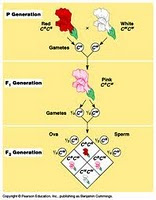

Aneuploidy: Having an extra or less chromosome.

Autosome: Any chromosome of a type that is the same in males and females of the species.

Crossing over: At prophase I of meiosis, genetic recombination is the result.

Deletion: loss of a segment from a chromosome.

Disease: Outcome of infection when defenses aren't mobilized fast enough and a pathogen's activiti

double-blind study: Different investigators independently collect, then compare data

Duplication: Gene sequence repeated several to many hundreds or thousands of times.

Genetic abnormality: A rare or less common version of a heritable trait.

Genetic disorder: Any inherited condition that causes mild to severe medical problems
Genetic Recombination: Result of any process that puts new genetic information into a DNA molecule.
Homologous chromosomes: One of a pair of Chromosomes indentical in size, shape and gene sequenc, and that interact at meiosis.
In-Vitro Fertilization: Conception outside the body.
Independent assortment: Mendelian Theory, each pair of homologous chromosomes are sorted before shipment to gametes independently of how the other pairs were sorted.
Inversion: Part of a chromosome that became oriented in reverse, with no molecular loss
karyotype: Preparation of metaphase chromosomes sorted by length, centromere location, other defining features.
Mosaicism: Cells of same type express genes differently, so phenotypic differences emerge in same type of tissue.
Non-disjunction: Failure of sister chromatids to separate during meiosis or mitosis.
Polyploidy: Having three or more of each type of chromosome in the nucleus of a eukaryotic cell at interphase.
Reciprocal Cross: A paired cross. In the first cross, one parent displays the trait of interest. In the second, the other parent displays it.
Sex Chromosome: A chromosome with genes that affects sexual traits (XX females. XY males)
Syndrome: A set of symptoms that may not individually be a telling clue but collectively characterize a genetic disorder or disease.
Translocation: movement of a stretch of DNA to a new chromosomal location with no molecular loss.
X Chromosomes: Type of sex xhromosome, that becomes female.
Y Chromosomes: type of sex chromosome, that become male.




































